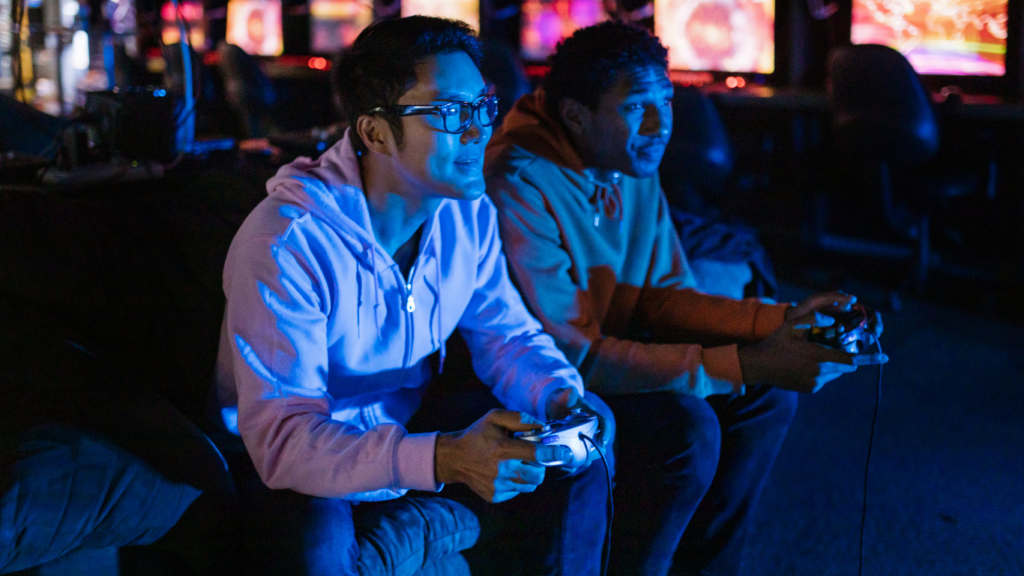The Evolution of E-Sports Rivalries
E-sports rivalries have transformed over the years, driven by advances in technology and expanding global reach. In the 2000s, professional gaming started with titles like StarCraft: Brood War. South Korea quickly became the epicenter due to the game’s popularity and the structured leagues developed there. Rivalries between top players like BoxeR and NaDa set early benchmarks for e-sports competition.
With the advent of high-speed internet, the scene expanded globally. Games like Counter-Strike: Global Offensive (CS:GO) saw Western and Eastern teams clash. Teams such as Astralis from Denmark and Fnatic from Sweden created intense rivalries, pushing each other to higher levels of gameplay. These competitions helped elevate the standard and visibility of e-sports, attracting sponsorships and larger audiences.
Streaming platforms like Twitch also revolutionized e-sports. They brought live matches directly to fans worldwide, turning players into celebrities. League of Legends (LoL) exemplified this trend, especially with teams like T1 and Royal Never Give Up (RNG). Their matches often broke viewership records, showcasing the sport’s massive appeal.
Newer titles like:
- Overwatch
- Fortnite
- Valorant
continue to develop their own rivalries. Teams like San Francisco Shock in Overwatch and FaZe Clan in Fortnite foster competitive narratives that keep audiences engaged. Each title contributes to the rich tapestry of e-sports, ensuring that rivalries evolve and diversify.
E-sports leagues and tournaments now mimic traditional sports formats, further solidifying rivalries. Regular seasons, playoffs, and world championships create recurring opportunities for teams to face off. This structure also builds anticipation and investment among fans.
E-sports rivalries have come a long way since their inception. Influenced by technological advancements, global connectivity, and dedicated platforms, they have grown into significant cultural phenomena. These rivalries not only drive games but also unite and excite communities worldwide.
Iconic Rivalries in League of Legends

The League of Legends (LoL) competitive scene has witnessed some of the most intense rivalries in e-sports history. These rivalries have captivated fans and driven the teams to new heights.
TSM vs. Cloud9
One of the most iconic rivalries in North American LoL is between Team SoloMid (TSM) and Cloud9 (C9). This rivalry began in 2013 when Cloud9 entered the professional scene and quickly established itself as a formidable opponent. Both teams have often battled it out in the North American League of Legends Championship Series (NA LCS), competing for the top spot.
Their matches are known for their high skill levels, strategic depth, and unpredictability. For example, the 2017 NA LCS Summer Finals saw TSM narrowly defeat Cloud9 in a 3-2 series, showcasing the intense competition between these two teams. The rivalry keeps fans eagerly anticipating each showdown.
Fnatic vs. G2 Esports
In Europe, the rivalry between Fnatic and G2 Esports is legendary. Fnatic, a historic team with a legacy of success, has often clashed with G2 Esports, a team that has risen to prominence in recent years. This rivalry intensified in the League of Legends European Championship (LEC).
Their battles are noted for their intensity and the high stakes involved. For instance, the 2020 LEC Spring Finals saw G2 Esports triumph over Fnatic with a 3-0 victory, cementing their dominance. However, Fnatic’s storied past and competitive spirit ensure that their encounters are always thrilling.
Both rivalries in League of Legends have contributed significantly to the game’s history and continue to be a major draw for fans worldwide.
Historic Clashes in Dota 2
Dota 2 features some of the most iconic e-sports rivalries, capturing fans’ imaginations with strategic depth and exhilarating gameplay.
Evil Geniuses vs. Team Secret
Evil Geniuses (EG) and Team Secret have dominated the Dota 2 scene, creating an intense rivalry marked by numerous high-stakes encounters. EG, an American organization, achieved their peak in 2015 by winning The International 5 (TI5). This victory cemented their status as a formidable team.
Conversely, Team Secret, founded by former pro player Clement “Puppey” Ivanov, has always been a European powerhouse. Though Secret didn’t win The International until 2021 (TI10), their consistent performances in major tournaments made them a fearsome adversary.
Notable clashes between EG and Team Secret often occur in premier tournaments like Majors and The International, showcasing not just the teams’ skills but also their evolving strategies. A memorable match from TI8’s upper bracket saw EG narrowly defeating Secret, intensifying the rivalry further.
OG vs. PSG.LGD
OG and PSG.LGD have set the gold standard for Dota 2 rivalries, particularly evident in their clashes during The International tournaments. OG, a European team, made history by winning back-to-back TI titles in 2018 and 2019. Their aggressive and unorthodox playstyle challenged conventional strategies.
PSG.LGD, representing China, is known for their disciplined and calculated approach. They consistently performed well, finishing as runners-up to OG in both TI8 and TI9. These finals were nail-biting spectacles, with OG’s innovative tactics ultimately prevailing over PSG.LGD’s meticulous gameplay.
The rivalry reached a pinnacle during TI8’s grand finals, where OG came back from a 2-1 deficit to win 3-2. These encounters have not only thrilled fans but also pushed the competitive meta in new directions.
These historic clashes remind us why Dota 2 remains a cornerstone of the e-sports world, captivating audiences with mesmerizing plays and unforgettable rivalries.
High-Stakes Showdowns in Counter-Strike: Global Offensive
Counter-Strike: Global Offensive (CS:GO) is known for its intense rivalries and high-stakes matches. These rivalries captivate fans and fuel the dynamic competitive scene.
Astralis vs. Team Liquid
Astralis and Team Liquid’s rivalry represents one of the most compelling narratives in CS:GO. Astralis, a Danish powerhouse, has dominated the scene with their strategic prowess and disciplined play.
Team Liquid, the North American giants, rose to prominence challenging Astralis’ reign. Their clashes often occur in the finals of prestigious tournaments like ESL One and Intel Extreme Masters. In 2019, Team Liquid finally broke Astralis’ winning streak, marking a pivotal moment in CS:GO history. The fierce battles between these two teams push gameplay to new heights.
Fnatic vs. Ninjas in Pyjamas
Fnatic and Ninjas in Pyjamas (NiP) boast one of the longest-standing rivalries in CS:GO. Both have storied histories, with Fnatic renowned for their aggressive strategies and NiP celebrated for their tactical ingenuity. Their intense matchups often took place at major events including DreamHack and ESL Pro League.
During the early years, NiP dominated with an 87-0 LAN streak, while Fnatic’s emergence challenged their supremacy. This rivalry symbolizes the evolution of competitive CS:GO, showcasing legendary players and unforgettable moments that have shaped the game’s legacy.
Emerging Rivalries in Newer E-Sports Titles
I’ve noticed that as new e-sports titles gain popularity, emerging rivalries create excitement and anticipation for the audience.
Valorant’s Most Intense Matchups
Valorant, launched by Riot Games, has quickly developed significant rivalries. The competition between Sentinels and 100 Thieves exemplifies this.
Their intense matches in various tournaments, like the Valorant Champions Tour, showcase top-tier gameplay and strategic depth. Meanwhile, teams like Fnatic and Team Liquid also engage in highly competitive bouts, particularly in regional tournaments like the EMEA Challengers, drawing massive viewers and shaping the meta of the game.
The Rising Stars of Apex Legends
- Apex Legends, developed by Respawn Entertainment, has seen new teams rise rapidly in the competitive scene.
- Teams like TSM and NRG have established themselves as dominant forces.
- Their matchups in the Apex Legends Global Series often feature aggressive playstyles and innovative strategies.
- Younger rosters like Sentinels and Complexity Gaming have started making a name for themselves, bringing fresh tactics and rivaling the established teams in thrilling showdowns.
- These engagements in high-stakes tournaments highlight the dynamic and ever-evolving nature of Apex Legends e-sports.
The Impact of Rivalries on E-Sports Culture
E-sports rivalries enhance both player focus and audience engagement. Iconic battles like TSM vs. Cloud9 and Astralis vs. Team Liquid inject excitement and dynamism into tournaments. These rivalries create compelling narratives that draw in viewers, increase team allegiance, and amplify the significance of each match.
Team dynamics and strategies evolve through rivalries. As teams like Fnatic and Ninjas in Pyjamas clash repeatedly, they adapt their tactics and gameplay to outsmart one another. This continuous evolution pushes the skill ceiling higher, leading to more innovative and thrilling gameplay, as seen in major events like ESL Pro League and DreamHack.
Rivalries also foster community growth and interaction. Fans develop strong connections with their favorite teams and players, often participating in community forums, social media, and live events. This active participation broadens the e-sports audience base and solidifies the community. Tournaments featuring Sentinels vs. 100 Thieves in Valorant, for example, drive online discussions and fan-generated content, contributing to the overall vibrancy of the e-sports culture.
Sponsorships and investments in e-sports benefit from intense rivalries. High-profile matchups attract bigger audiences, drawing sponsors and advertisers looking to capitalize on the viewership. Companies involved in e-sports see substantial returns on investments due to the visibility and engagement these rivalries generate. Key matchups like T1 vs. Royal Never Give Up in League of Legends exemplify how high-stakes competition can attract high-profile sponsorships.
Rivalries also impact player career trajectories. Players in rival teams often become focal points of media coverage and fan attention. Consistent high-level performances in rivalry matches can elevate a player’s reputation and market value. Matches like Evil Geniuses vs. Team Secret in Dota 2 spotlight players who rise to prominence through their consistent dominance and clutch plays.
Rivalries shape the whole e-sports scene, enhancing everything from gameplay quality to community engagement, financial investments, and individual player careers.


